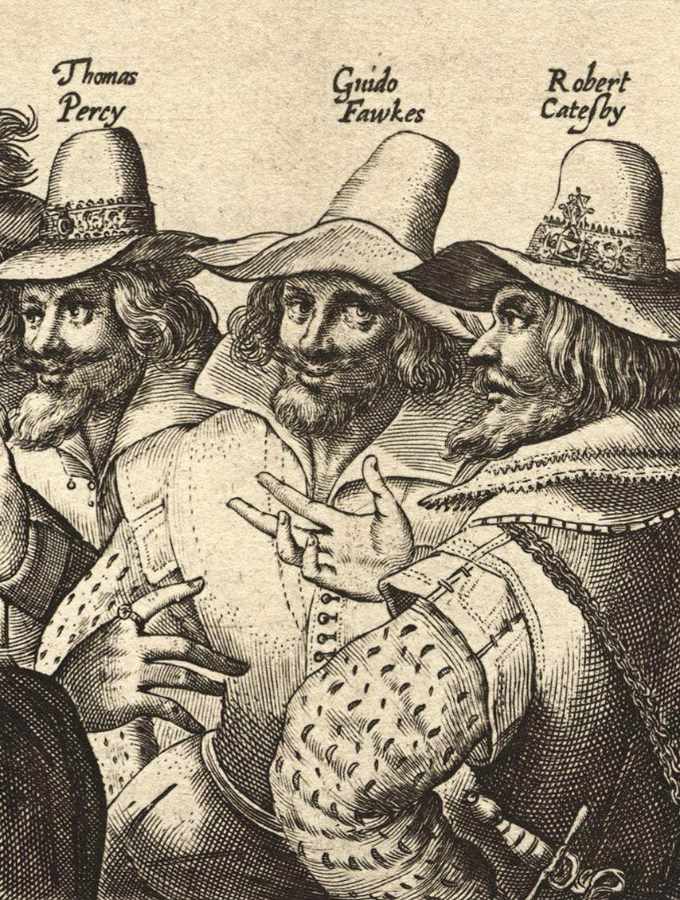Guy Fawkes, also known as Guido Fawkes, the name he adopted while fighting for the Spanish in the Low Countries, was a member of a group of provincial English Catholics who planned the failed Gunpowder Plot of 1605. Fawkes fought in the Eighty Years’ War on the side of Catholic Spain against Protestant Dutch reformers. He later met Thomas Wintour, who introduced Fawkes to Robert Catesby, who planned to assassinate King James I and restore a Catholic monarch to the throne. The plotters secured the lease to an undercroft beneath the House of Lords, and Fawkes was placed in charge of the gunpowder they stockpiled there. Prompted by the receipt of an anonymous letter, the authorities searched Westminster Palace during the early hours of 5 November, and found Fawkes guarding the explosives. Over the next few days, he was questioned and tortured, and eventually he broke. Immediately before his execution on 31 January, Fawkes jumped from the scaffold where he was to be hanged and broke his neck, thus avoiding the agony of the mutilation that followed. Fawkes became synonymous with the Gunpowder Plot, the failure of which has been commemorated in England since 5 November 1605. His effigy is traditionally burned on a bonfire, commonly accompanied by a firework display. Guy Fawkes Night, also known as Guy Fawkes Day, Bonfire Night, and Firework Night, is an annual commemoration observed on 5 November, primarily in Great Britain. Celebrating the fact that King James I had survived the attempt on his life, people lit bonfires around London, and months later the introduction of the Observance of 5th November Act enforced an annual public day of thanksgiving for the plot’s failure. A stylized depiction of Guy Fawkes was popularly worn by V from Alan Moore’s V for Vendetta, and by the cyber-activist group Anonymous.
| Alias Guy Fawkes |
| Real Names/Alt Names Guy Fawkes |
| Characteristics Film Characters, Historical Figures, Pulp Characters, War Stories, The Renaissance, British |
| Creators/Key Contributors ○ |
| First Appearance Historical figure (b. 1570 – d. 1606) |
| First Publisher ○ |
| Appearance List English folk verse with no known original author; A True and Perfect Relation of the Whole Proceedings against the late most barbarous Traitors… (1606); “In Quintum Novembris” (“On the Fifth of November”, 1626) by John Milton, celebrating the anniversary of the Gunpowder Plot; The Gunpowder-Treason: With a Discourse of the Manner of its Discovery (1679) by Thomas Barlow (ed.); Guy Fawkes or, A Complete History of the Gunpowder Treason (1839) by Thomas Lathbury; Guy Fawkes; or, The Gunpowder Treason (1841, book ed.; 1840 serial) by William Harrison Ainsworth; A Narrative of the Gunpowder Plot (1857) by David Jardine; The Condition of Catholics under James I: Father Gerard’s Narrative of the Gunpowder Plot (1871/1872) by John Gerard (1564–1637), ed. John Morris; What was the Gunpowder Plot? The Traditional Story Tested by Original Evidence (1897) by John Gerard (1840–1912); A History of the Gunpowder Plot: The Conspiracy and Its Agents (1905) by “Philip Sidney”; Gunpowder, Treason and Plot (1976) by C. Northcote Parkinson. Film: Please to Remember the 5th of November – But Bridgwater Celebrates (1922, Topical Film Co.); Guy Fawkes (1923) by Maurice Elvey; Guy Fawkes Day Preparations at Belle Vue (1930) by Gaumont Graphic (newsreel; British Pathé archive); Remember… Remember… The Fifth of November (1932) by British Pathé (newsreel); Kingston – “Guy Fawkes – Mars” (1938) by British Pathé (newsreel); Guy Fawkes Celebrations (1938) by British Pathé (newsreel); Bonfire Night (1957) by Alan Sidi (amateur film; Yorkshire Film Archive); Penny for the Guy? (1961) by Westward Television; reporter Roger Malone. |
| Sample Read A History of the Gunpowder Plot; the conspiracy and its agents [Internet Archive] |
| Description Guy Fawkes, also known as Guido Fawkes, the name he adopted while fighting for the Spanish in the Low Countries, was a member of a group of provincial English Catholics who planned the failed Gunpowder Plot of 1605. Fawkes fought in the Eighty Years’ War on the side of Catholic Spain against Protestant Dutch reformers. He later met Thomas Wintour, who introduced Fawkes to Robert Catesby, who planned to assassinate King James I and restore a Catholic monarch to the throne. The plotters secured the lease to an undercroft beneath the House of Lords, and Fawkes was placed in charge of the gunpowder they stockpiled there. Prompted by the receipt of an anonymous letter, the authorities searched Westminster Palace during the early hours of 5 November, and found Fawkes guarding the explosives. Over the next few days, he was questioned and tortured, and eventually he broke. Immediately before his execution on 31 January, Fawkes jumped from the scaffold where he was to be hanged and broke his neck, thus avoiding the agony of the mutilation that followed. Fawkes became synonymous with the Gunpowder Plot, the failure of which has been commemorated in England since 5 November 1605. His effigy is traditionally burned on a bonfire, commonly accompanied by a firework display. Guy Fawkes Night, also known as Guy Fawkes Day, Bonfire Night, and Firework Night, is an annual commemoration observed on 5 November, primarily in Great Britain. Celebrating the fact that King James I had survived the attempt on his life, people lit bonfires around London, and months later the introduction of the Observance of 5th November Act enforced an annual public day of thanksgiving for the plot’s failure. A stylized depiction of Guy Fawkes was popularly worn by V from Alan Moore’s V for Vendetta, and by the cyber-activist group Anonymous. |
| Source Guy Fawkes – Wikipedia |

